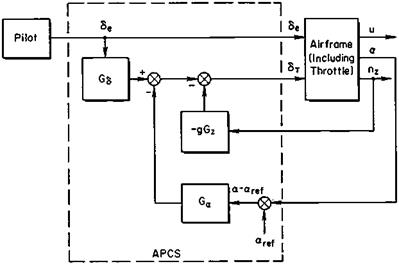Standard Carrier Approaches
Naval aviators have developed a distinctive landing approach procedure to make touchdown point precision a routine matter. U. S. carrier-based airplanes turn onto a short final approach path in a steep left turn, avoiding as much as possible the ship’s turbulent wake or burble. Carrier final approaches are typically less than 3/4 mile long, taking some 15 to 20 seconds to complete (Craig, Ringland, and Ashkenas, 1971).
In manually flown approaches the pilot relies on an optical projection device for a vertical reference, rather than the view of the ship’s landing area. The optical device, mounted on the carrier’s deck, is gimbaled to project a stable glide slope. The pilot sees a projection of a solid circle and short horizontal datum bar. Below the glide slope the ball appears below the bar, and vice versa. Radar-controlled automatic carrier landings have also been developed, using an SPN-42 tracking radar mounted on the ship. Aircraft attitude changes are sent as commands to the airplane’s pitch attitude autopilot, to correct perceived height errors relative to the ideal glide path.
|
Figure 12.1 Block diagram for the AN/ASN-54 Approach Power Compensation System. This was designed for carrier airplanes to hold the angle of attack constant using thrust variations. However, path control was unsatisfactory using this system. (From Craig, Ringland, and Ashkenas, Syst. Tech., Inc. Rept. 197-1, 1971) |
In order to control airspeed closely, the final approach is made at a constant angle of attack. Precise control of angle of attack as a means of controlling airspeed is considered so important that a special throttle control system – the Approach Power Compensation System, or APCS – was developed for that purpose. There were many experiments with different feedbacks; the final APCS design uses angle of attack and normal acceleration feedbacks to the throttle and some pilot stick feedforward (Figure 12.1).












